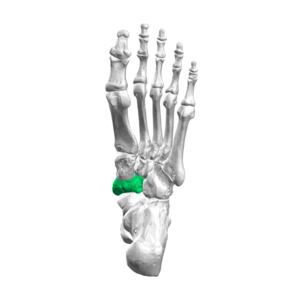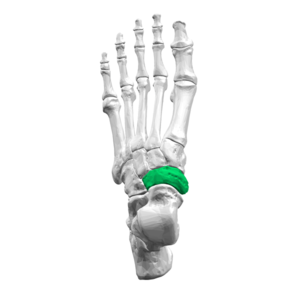Navicular
21/09/2020/
Original Editor - Alex Benham
Top Contributors - Alex Benham, Lucinda hampton, Fasuba Ayobami and Kim Jackson
Description[edit | edit source]
The navicular bone is one of the seven bones which make up the tarsus of the Ankle and Foot. It is located on the medial aspect of the foot, next to the cuboid bone, anterior to the head of the talus and posterior to the cuneiform bones. It is one of the five bones of the midfoot[1].
Structure[edit | edit source]
The navicular is a small irregular bone with its shape being described as pyriform[3]. Its posterior surface is concave and there are two faint ridges anteriorly to correspond with the articulation with the three cuneiform bones. There is a large protuberance on the inferomedial aspect of the navicular bone called the navicular tuberosity [1] which is often simple to palpate in the area directly anteroinferior to the medial malleolus.
Function[edit | edit source]
The navicular is sometimes referred to as the keystone of the medial longitudinal arch of the foot, corresponding to its location at the peak of the arch and its role in maintaining the arch of the foot.
Articulations[edit | edit source]
The acetabulum pedis is the common name for the talocalcaneonavicular joint and forms the subtalar articular complex along with the posterior talocalcaneal joint. It has some of the morphological characteristics of a ball and socket joint which led to its name[4]. The skeletal structures included are the posterior articular surface of the navicular bone, and the anterior and middle articular surface of the calcaneus that articulate with the head and the anteromedial surface of the talus. These bones are stabilized by the plantar calcaneonavicular ligament (spring ligament) on the medial aspect and the lateral calcaneonavicular ligament (a component of the bifurcate ligament) on the lateral aspect.[4]
Muscle and Ligamentous Attachments[edit | edit source]
The only muscle attachment on the navicular is the tendon of the tibialis posterior. This a muscle located within the deep compartment of the posterior aspect of the tibia and the tendon extends inferiorly around the medial malleolus to insert on the navicular tuberosity. [3]
There are many ligamentous attachments to the navicular bone. The plantar calcaneonavicular ligament attaches inferiorly and is otherwise known as the spring ligament. It is a group of ligaments that connect the navicular to the calcaneus, forming a type of socket for the head of the talus, although the extent of its structure and morphology is debated in the literature [5]
The superomedial calcaneonavicular ligament originates from the anteromedial margins of the sustentaculum tali on the talus bone. From there, it extends in an anterodorsolateral direction to the posterior aspect of the navicular and also attaches to the posterior tibial tendon [4]
The inferior calcaneonavicular ligament arises from the superior portion of the coronoid fossa, anterior to the sustentaculum tali. Its insertion is on the lateral, plantar aspect of the navicular, just lateral to the superomedial calcaneonavicular ligament insertion. The inferior calcaneonavicular ligament performs as one of the main static stabilizers of the longitudinal arch of the foot.[5]
The bifurcate ligament is a Y-shaped structure originating at two separate origins: The lateral calcaneonavicular ligament and the medial calcaneocuboid ligament. The lateral calcaneonavicular ligament originates from the lateral side of the anterior talar articular surface, anteromedially from the sinus tarsi. these fibres form a durable band that facilitates the lateral foot stabilization.[6]
Clinical relevance[edit | edit source]
There are several clinical conditions which involve the navicular directly. The navicular is often subject to developing stress fractures and can lead to Navicular stress syndrome. Müller Weiss syndrome is a spontaneous adult onset osteonecrosis of the navicular bone which may be picked up radiographically. In children, there is also a similar condition, although distinct from Müllers Weiss syndrome called Koehlers syndrome[7].
One common association is the abnormality called Accessory Navicular Bone,
The navicular is also used clinically within the Navicular Drop Test which may be used as a measure of foot pronation.
References[edit | edit source]
- ↑ 1.0 1.1 Soames RW. Anatomy and Human Movement E-Book: Structure and function. Elsevier Health Sciences; 2018 Aug 22.
- ↑ Viren Kariya. Navicular Bone. Available from: https://www.youtube.com/watch?v=xf3ZdsyGaiI [Last accessed 21/09/2020]
- ↑ 3.0 3.1 Golano P, Fariñas O, Sáenz I. The anatomy of the navicular and periarticular structures. Foot and ankle clinics. 2004 Mar 1;9(1):1-23.
- ↑ 4.0 4.1 4.2 Epeldegui T, Delgado E. Acetabulum pedis. Part I: Talocalcaneonavicular joint socket in normal foot. Journal of pediatric orthopedics. Part B. 1995;4(1):1-0.
- ↑ 5.0 5.1 Prapto D, Dreyer MA. Anatomy, Bony Pelvis and Lower Limb, Navicular Bone.
- ↑ Kafka RM, Aveytua IL, Choi PJ, DiLandro AC, Tubbs RS, Loukas M, Mintz DN, Baidya R, Kumar S, Sangari SK, Mtui EP. Anatomico-radiological study of the bifurcate ligament of the foot with clinical significance. Cureus. 2019 Jan;11(1).
- ↑ Samim M, Moukaddam HA, Smitaman E. Imaging of Mueller-Weiss syndrome: a review of clinical presentations and imaging spectrum. American Journal of Roentgenology. 2016 Aug;207(2):W8-18.








